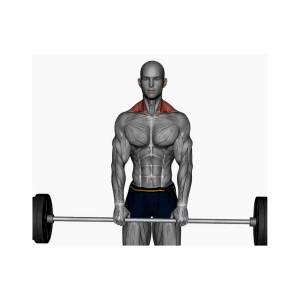Barbell shrugs
Barbell shrugs are a weightlifting exercise that targets the muscles in your neck and upper back, primarily the trapezius. The exercise is performed by holding a barbell with a wide grip, shrugging your shoulders upward towards your ears, and then lowering them back down.
Barbell shrugs can help improve neck and upper back strength and may also help with posture.
Main muscles used doing barbell shrugs
The main muscles used during barbell shrugs are the trapezius muscles, which are located in the neck and upper back. The exercise also engages the levator scapulae and the rhomboids, which are smaller muscles that help with stability and movement in the upper back.
Instructions on how to do barbell shrugs
Here’s a step-by-step guide on how to do a barbell shrug:
- Stand with your feet shoulder-width apart and grab a barbell with a wide grip, using an overhand grip.
- Keep your chest up and your back straight.
- Shrug your shoulders straight up towards your ears, keeping your arms straight and the barbell close to your body.
- Hold for a second at the top, then lower your shoulders back down to the starting position.
- Repeat the movement for the desired number of repetitions.
It’s important to use proper form while performing barbell shrugs to avoid injury and to target the muscles effectively. Use a weight that allows you to complete the desired number of reps with good form.
Tips for doing barbell shrugs
Here are some tips for doing barbell shrugs:
- Use proper form: Keep your chest up, your back straight, and your arms straight throughout the exercise.
- Focus on using your trapezius muscles: The barbell shrugs should primarily target the trapezius, so concentrate on shrugging your shoulders straight up towards your ears.
- Don’t use too much weight: Using too much weight can cause you to use improper form, putting you at risk of injury. Start with a lighter weight and gradually increase as your strength improves.
- Keep your movements controlled: Avoid swinging the weight or using momentum to complete the reps.
- Warm up: Warm up before you begin your workout to prevent injury and increase your range of motion.
- Vary your grip: You can switch up your grip (wide, narrow, mixed) and the placement of your hands on the bar to target different parts of your trapezius.
- Focus on your breathing: Exhale as you raise your shoulders and inhale as you lower them.
By following these tips, you can perform barbell shrugs safely and effectively, helping build strength and improve your neck and upper back posture.
Benefits of doing barbell shrugs
Barbell shrugs offer several benefits, including:
- Improving neck and upper back strength: Barbell shrugs help to build strength in the muscles of the neck and upper back, including the trapezius, levator scapulae, and rhomboids.
- Improving posture: Strong neck and upper back muscles can help improve posture and reduce the risk of injury.
- Relieving tension: Barbell shrugs can help relieve tension in the neck and upper back, making them a useful exercise for people who sit at a desk for long periods of time.
- Improving athletic performance: Improved neck and upper back strength can benefit athletes in sports that require overhead movements, such as throwing or jumping.
- Increasing muscle mass: Barbell shrugs can help to increase muscle mass in the neck and upper back, contributing to a more aesthetically pleasing physique.
It’s important to note that barbell shrugs should be incorporated into a well-rounded workout program that includes exercises for other muscle groups and also includes proper nutrition and recovery.
For other shoulder exercises like dumbbell shrugs, go to http://bptrainingcoaching.com/shoulder-exercises/.

